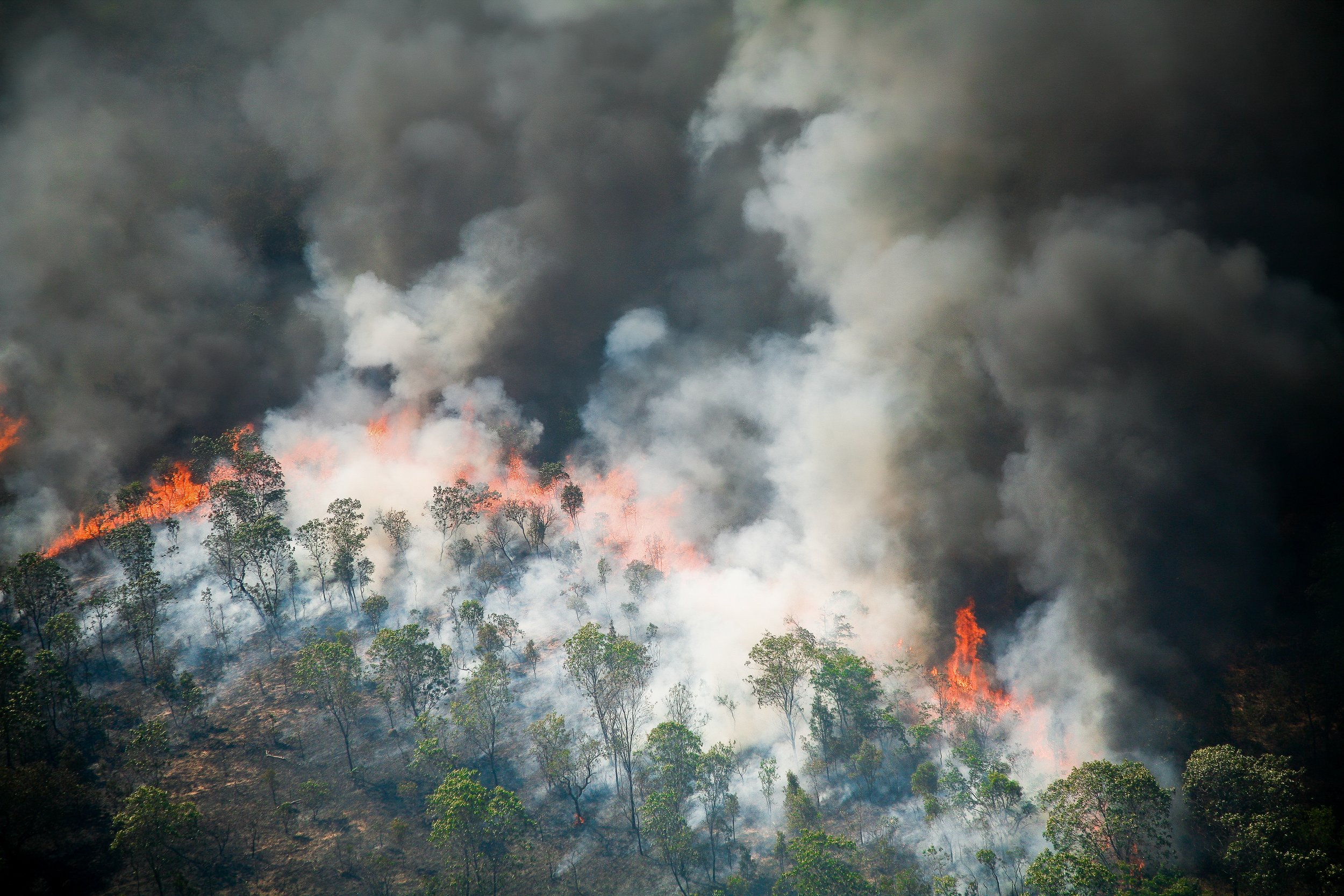The Amazon is on fire — here is why
2024 marks the worst year for fires in the Amazon Rainforest since 2005. This year, the total burned area amounts to 13.4 million acres—an area larger than the countries of Costa Rica or Denmark. But why? And what can be done to stop it?
First, it is important to clarify some important information about fires in the Amazon:
Fires in the Amazon are caused by humans. The Amazon Rainforest does not burn naturally and is not naturally adapted to fire.
Fires in the Amazon are generally started to clear land, or to “clean” previously cleared land, most commonly to make space for cattle ranching.
Climate change is making the Amazon more susceptible to fires. Increasingly common and severe droughts allow fires to spread rapidly.
Satellite imagery data from southern Peru confirms the strong links between humans and fires in the Amazon. Below, you can see that the location of fires in the province of Madre de Dios is not random, but actually correlated with the regions only paved road – the interoceanic highway. The road, which was constructed ~15 years ago, has since catalyzed deforestation for agriculture and gold mining, including the use of fires. Many locals also comment on the rise of organized crime following the road construction related to gold mining that has transformed the capital city of Puerto Maldonado.
A side-by-side view of highways and fires in Madre de Dios, Peru, demonstrating the strong relationship between human activity and fire damage in the Amazon. You can track the fires yourself using this website. Data: NASA; Map: Ethan Duvall (ARCC)
Regional governance also has an important role to play in recent fires. For example, recent changes in Peru’s land titling and tenure laws have made the granting of land titles possible only for land that is “demonstrably under cultivation” — that is, without forest cover. This change promotes land clearing for land ownership, a key to generational wealth for Peru’s marginalized populations. A more blatant incentive for deforestation could not be designed.
As you look at the map of Madre de Dios above, you can see vast expanses of green rainforest to the west of the fires, stretching for hundreds of kilometers. These areas are home to several groups of indigenous peoples, including the Mashco Piro, who live in voluntary isolation. These areas, as well as the world renowned Manu National Park, are simultaneously designated for timber and gas extraction, threatening the people, biodiversity, and fire resiliency that the area harbors.
Indigenous populations play an imperative role in protecting rainforest from fire and eventual conversion to cattle pasture and corn fields. These patterns are observable from space (see image below), where many of the remaining “islands of green” circumscribed by fire are indigenous reserves, including the Xingu Indigenous Park, shared between multiple tribes on the Xingu River, as well as the lands of the Kayapo and the Munduruku tribes. In fact, indigenous-managed lands in the Amazon are some of the most reliable “carbon sinks” in the world.
Current fires in Brazil demonstrate the importance of indigenous territories for protecting rainforest and increasing its resiliency to fire. The Xingu Indigenous Park, shown above, remains largely "green" while surrounded by fires. Data: NASA; Map: Ethan Duvall (ARCC)
While it is easy to point fingers and cast blame at the loggers and farmers, the sad reality is that, for the most part, these people are poorly paid mercenaries – merely the front lines of much larger extractive industries (e.g., cattle ranching, agriculture, mining). These workers will see very little of the profits made from the Amazon’s destructions.
So, what can be done to reduce the impacts of fire in the Amazon Rainforest?
Careful assessment of roadbuilding and infrastructure projects: The social and environmental impacts of these developments in the Amazon must be thoroughly considered. In today's world, halting road construction into untouched areas remains one of the most effective strategies for protecting the forest.
Respect for indigenous lands: Indigenous communities have proven to be among the most effective stewards of the rainforest. Supporting their self-determination and safeguarding their territories ensures that the forests they rely on for their way of life are preserved.
Providing economic opportunities, healthcare, and education to local communities: The global economy currently prioritizes cheap goods, such as beef and timber, from tropical forests. Shifting this focus toward sustainable development and ensuring local communities have access to better economic, healthcare, and educational opportunities will alleviate the pressure on forest resources.
What can I do to help?
Donate to organizations and indigenous groups working together to protect land and biodiversity in the Amazon Rainforest. These groups are often the frontline defenders against deforestation, illegal logging, and land clearing, which are key drivers of fires.
Petition against illegal highway construction in the Amazon. Here are several petitions you can sign online to support indigenous groups in their fight to protect the Amazon from undesired road construction projects:
Reduce your beef consumption. A large majority of the the Amazon is cleared to make way for cattle ranching, or to grow food for beef in other countries. This is a major source of deforestation and subsequent fires.
Make climate-conscious decisions. Climate change is intensifying droughts and altering weather patterns, making the Amazon more vulnerable to wildfires. By supporting climate-conscious initiatives, and cutting down on personal carbon footprints—through energy efficiency, sustainable choices, and lifestyle changes—we can slow global warming and reduce frequent and severe fires.
Raise awareness about the Amazon’s fight against fire. We must all work to encourage public pressure on governments, businesses, and policymakers to take action. When more people understand the urgency, they can help drive systemic changes, such as implementing policies to curb deforestation and prevent fires.
Fire smoldering in a recently cleared agricultural plot in the Peruvian Amazon, a place that was forest a few months ago. Photo: Joseph See (ARCC)




